Friday, October 11, 2013
1967-68 St. Louis Blues Gary Sabourin Jersey
Since the demise of the Brooklyn Americans in 1942, the NHL consisted of just six member teams, commonly referred to as "The Original Six". Finally, following the success of the Los Angeles Dodgers and San Francisco Giants of Major League Baseball on the west coast, the idea of expanding the NHL was first brought up in 1963, partly due to concerns that the Western Hockey League was intending to operate as a major league in the near future and also in hopes of making the league more attractive to American television networks with coast-to-coast appeal.
The original discussions promoted San Francisco and Vancouver as acceptable locations with Los Angeles and St. Louis also as potential candidates in March of 1965.
In February of 1966, applications were received from groups from Los Angeles, Pittsburgh, Minnesota, Philadelphia, San Francisco, Baltimore, Buffalo and Vancouver. But not St. Louis.
In the end, franchises were awarded to Oakland (across the bay from San Francisco), Los Angeles, Minnesota, Philadelphia, Pittsburgh and...
St. Louis!
The decision to exclude Vancouver caught many by surprise, especially those involved in the construction of the brand new Pacific Coliseum in Vancouver, and angered not only the locals, but all of Canada, since the six chosen cities were all in the United States. Various reasons emerged to explain the surprise inclusion of St. Louis, despite the fact there was no formal proposal from a group representing St. Louis.
Reportedly, the Toronto Maple Leafs and Montreal Canadiens did not want to share Canadian TV revenues with a third club and support for any expansion from the Chicago Black Hawks was contingent on the creation of a team in St. Louis, which would result in a near by rival as well as the sale of the run-down St. Louis Arena, which just conveniently happened to be owned by the Chicago Black Hawks ownership group at the time...
The St. Louis Arena
With the franchise now granted, the club's original owners spent several million dollars to massively renovate the arena, which included expanding it's capacity from 12,000 to 15,000 seats.
While Lynn Patrick was the original St. Louis Blues head coach, the legendary Scotty Bowman took over after a mere 16 games a roster which included veteran players Dickie Moore, leading scorer Red Berenson (51 points in 55 games after arriving in a trade) and goaltender Glenn Hall. While many of the players on the roster were NHL rookies or players with very limited NHL experience, they were not fresh-faced kids just out of juniors, but grizzled veterans with many seasons of minor league experience who were unable to crack the rosters of the Original 6 era, but who were more than capable of competing in the now 12 team NHL, some of whom would remain with the Blues for many seasons to come. Players such as Frank St. Marseille, Gary Sabourin, Barclay Plager, Noel Picard and Bob Plager.
The 1967-68 St. Louis Blues
That club would play the first game in franchise history on this date in 1967, when the Blues hosted their fellow expansion brothers the Minnesota North Stars at the arena in a game which ended in a 2-2 tie.
While the Blues had a rough early going, sinking to a 5-16-2 record, which included a 2-11 stretch in November and early December, the team came together following the coaching change to Bowman on November 20th. From December 9th to the end of January, the Blues reeled off a 13-5-6 run to climb to within 3 games of .500. Over the final two months of the campaign, the Blues won 9, lost 10 and tied 8 to finish the regular season with a 27-31-16 record for 70 points, just three back of the Philadelphia Flyers, and a spot in the playoffs.
As a way to allow the six new teams a chance to be competitive, or at least maintain the illusion of competitiveness for their fans, the six new clubs were placed together in the West Division, while the Original 6 teams comprised the East Division with the first two rounds of the playoffs conducted within one division, ensuring one of the new expansion teams a berth in the Stanley Cup finals.
The imbalance in the established clubs strength versus the six new teams was evident heading into the playoffs, as the fifth team in the East and first non-qualifyer for the playoffs, the Maple Leafs, had more points in the standings (76) than the all the teams in the West, led by Philadelphia's 73!
For whatever reason, the logic of the day dictated that the third place Blues drew the first place Flyers in the opening round, rather than the Flyers taking on the fourth place North Stars, as would be the case today. Regardless, the Blues, led by Hall's superb goaltending, shut out the Flyers at home in Game 1 by a score of 1-0. Philadelphia rebounded in Game 2 with a 4-3 win but St. Louis put the Flyers on the brink of elimination with 3-2 in overtime and 5-2 wins back at home.
The Flyers stayed alive with a dominant 6-1 back in Philadelphia and then forced a Game 7 when they defeated the Blues 2-1 in overtime in St. Louis. The Blues then eliminated the Flyers on the road 2-1 to advance to the semifinals where they would meet Minnesota.
That series would prove to be a knock-down, drag-out affair. The teams split the first two games in St. Louis, with the second one going to Minnesota in overtime. The North Stars took a 2-1 series lead before the Blues won the fourth game 4-3 in overtime to even the series at 2-2. St. Louis won 3-2 back at home in overtime followed by the North Stars holding serve at home in Game 6 by a score of 5-1. The deciding Game 7 was tied at 1-1 at the end of regulation before the Blues advanced to the Stanley Cup finals with the deciding goal at 22:50 of overtime, the fourth extra period of the seven game series.
Now forced to face the powerful Canadiens of the Original 6, the survivor of the East Division, the Blues acquitted themselves well, but fell in Game 1 3-2 in overtime and 1-0 at home before dropping Game 3 in overtime 4-3. Montreal then completed the sweep at home with a 3-2 win, bringing to an end the Blues exciting first season in the NHL. It would be the fourth game decided by a single goal thanks to the inspired play of Hall, who was praised by writer Red Burnett "A number of Hall's saves were seemingly impossible. Experts walked out of the Forum convinced no other goaltender had performed so brilliantly in a losing cause."
Today's featured jersey is a 1967-68 St. Louis Blues Gary Sabourin jersey from the Blues first season of play in the NHL. This first year Blues jersey is distinguished by the yellow waist and sleeve stripes, which would reverse colors for the playoffs and beyond.
Names were not worn on the backs of the white Blues jerseys until 1974-75. This original Blues style, albeit with the change in waist and sleeve stripes, would remain in use all the way through the 1983-84 season although the logo has stood the test of time and remains in use through today.
Today's video section begins with highlights of the 1968 Stanley Cup finals, set to some hip tunes probably better suited to surfing highlights.
Next is a better song, the one which inspired the club's name, the St Louis Blues sung by Bessie Smith.
Labels:
Hall Glenn,
St. Louis Blues
Subscribe to:
Post Comments (Atom)

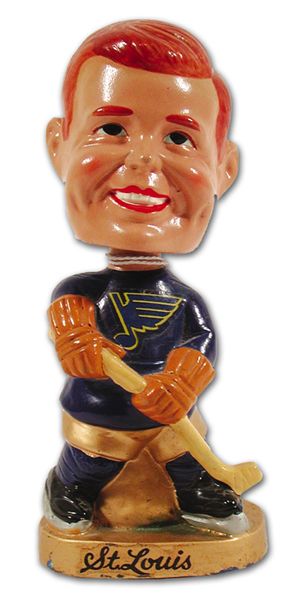
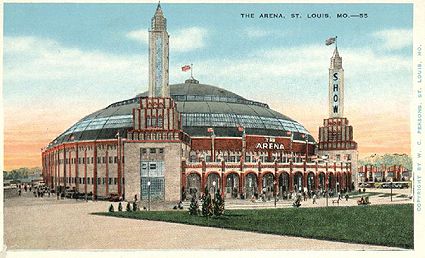
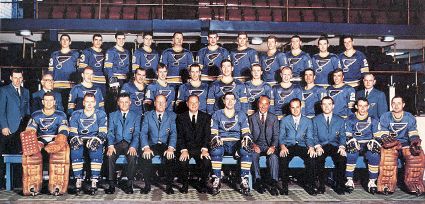
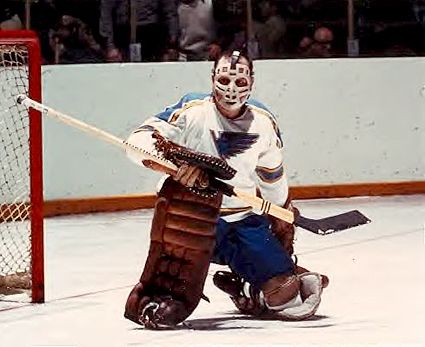
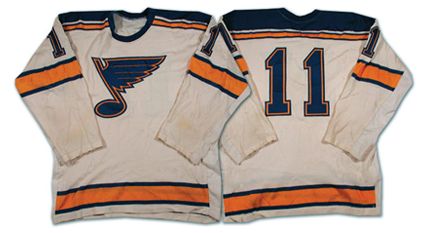










No comments:
Post a Comment
We welcome and encourage genuine comments and corrections from our readers. Please no spam. It will not be approved and never seen.